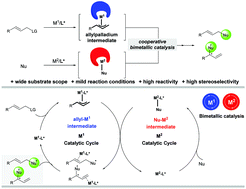当前位置:
X-MOL 学术
›
Org. Biomol. Chem.
›
论文详情
Our official English website, www.x-mol.net, welcomes your feedback! (Note: you will need to create a separate account there.)
Cooperative bimetallic catalysis in asymmetric allylic substitution
Organic & Biomolecular Chemistry ( IF 3.2 ) Pub Date : 2017-11-09 00:00:00 , DOI: 10.1039/c7ob02476b Jingke Fu 1, 2, 3, 4 , Xiaohong Huo 1, 2, 3, 4 , Bowen Li 1, 2, 3, 4 , Wanbin Zhang 1, 2, 3, 4, 5
Organic & Biomolecular Chemistry ( IF 3.2 ) Pub Date : 2017-11-09 00:00:00 , DOI: 10.1039/c7ob02476b Jingke Fu 1, 2, 3, 4 , Xiaohong Huo 1, 2, 3, 4 , Bowen Li 1, 2, 3, 4 , Wanbin Zhang 1, 2, 3, 4, 5
Affiliation

|
Synergistic catalysis is gaining increasing attention due to its advantages over traditional catalytic methodologies, such as improved catalytic activity, broader substrate scope, increased selectivity and lower cost. Methodologies involving the synergistic combination of metal catalysts and organocatalysts have been intensively studied. Given the clear benefits of bimetallic catalyst systems consisting of two distinct metal catalysts, cooperative bimetallic catalysis has proved to be successful for a number of difficult asymmetric transformations. This review highlights the recent advances in bimetallic systems for catalytic asymmetric allylic substitution reactions. Strategies using a chiral metal catalyst and the cooperative effect of a second achiral metal catalyst for asymmetric transformations are discussed. Additionally, several challenging asymmetric reactions realized by employing two different chiral metal catalysts in a synergistic manner are also covered.
中文翻译:

不对称烯丙基取代中的合作双金属催化
协同催化由于其优于传统催化方法的优点而受到越来越多的关注,例如改进的催化活性,更大的底物范围,更高的选择性和更低的成本。已经深入研究了涉及金属催化剂和有机催化剂的协同组合的方法。鉴于由两种截然不同的金属催化剂组成的双金属催化剂体系具有明显的优势,协同双金属催化已被证明可成功用于许多困难的不对称转化。这篇综述突出了催化不对称烯丙基取代反应的双金属体系的最新进展。讨论了使用手性金属催化剂的策略以及第二种非手性金属催化剂对不对称转化的协同作用。此外,
更新日期:2017-11-09
中文翻译:

不对称烯丙基取代中的合作双金属催化
协同催化由于其优于传统催化方法的优点而受到越来越多的关注,例如改进的催化活性,更大的底物范围,更高的选择性和更低的成本。已经深入研究了涉及金属催化剂和有机催化剂的协同组合的方法。鉴于由两种截然不同的金属催化剂组成的双金属催化剂体系具有明显的优势,协同双金属催化已被证明可成功用于许多困难的不对称转化。这篇综述突出了催化不对称烯丙基取代反应的双金属体系的最新进展。讨论了使用手性金属催化剂的策略以及第二种非手性金属催化剂对不对称转化的协同作用。此外,



























 京公网安备 11010802027423号
京公网安备 11010802027423号